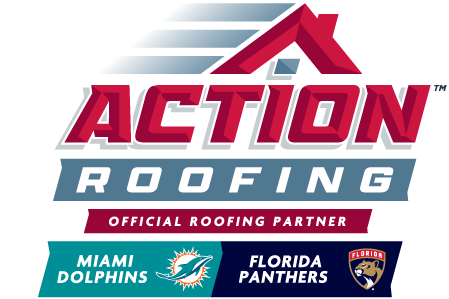Florida’s warm, humid climate can take a toll on your home, especially your roof. Without proper ventilation, heat and moisture get trapped in the attic, making your home hotter, increasing energy bills, and even leading to problems like mold and wood rot. A roof with good airflow lets hot air leave and cold air come in, keeping temperatures balanced and preventing moisture buildup. Action Roofing in Ft. Lauderdale, FL has helped countless Florida homeowners improve their roof ventilation, creating a more comfortable and efficient living space.
How Roof Ventilation Helps Beat the Heat
When the sun is beating down all day, the temperature inside your attic can soar. Without proper ventilation, heat builds up, making your home harder to cool. A poorly ventilated attic traps hot air, which then seeps into your living spaces, forcing your air conditioner to work harder than it should. Instead of escaping, all that heat lingers under your roof, creating a stuffy, overheated environment that pushes up your energy bills.
A well-ventilated roof helps move hot air out and lets cooler air flow in, keeping attic temperatures under control. Ridge vents, soffit vents, and attic fans work together to create a steady airflow that prevents heat from settling in. This not only makes your home feel cooler but also reduces the strain on your AC system. When hot air escapes, instead of building up, your cooling system doesn’t have to run nonstop just to maintain a comfortable temperature.
If you’ve ever noticed that your upstairs rooms feel hotter than the rest of the house, poor attic ventilation could be the reason. Heat trapped in the attic radiates downward, making it difficult to keep your home evenly cooled. Even lowering the thermostat won’t completely fix the problem if the heat has nowhere to go. By improving ventilation, you allow excess heat to escape naturally, creating a more comfortable and energy-efficient home.
Preventing Moisture Buildup and Mold Growth
Florida’s high humidity isn’t just uncomfortable—it can also create big problems for your home if moisture gets trapped in the wrong places. Without good ventilation, warm, humid air gets stuck inside your attic, leading to condensation. Over time, that excess moisture can soak into wood beams, insulation, and drywall, creating the perfect conditions for mold and mildew.
Mold isn’t just something you see growing in a damp bathroom or basement. It can spread through your attic, feeding on wood and other organic materials. If you’ve ever noticed a musty smell upstairs or seen dark spots forming on the ceiling, trapped moisture could be the culprit. Left unchecked, mold growth can weaken your roof structure and lead to expensive repairs.
Good ventilation helps prevent moisture problems by letting damp air escape before it builds up. Ridge vents, soffit vents, and attic fans keep air moving, reducing humidity and stopping condensation. This protects your home from damage and improves indoor air quality by cutting down on mold and allergens.
Extending the Life of Your Roof
A well-ventilated roof doesn’t just keep your home cool—it also helps your roofing materials last longer. When heat and moisture build-up in an attic, they can cause shingles to age faster, leading to cracking, curling, and premature wear. Without proper airflow, the extreme heat trapped under your roof can damage the underlayment and weaken the entire structure over time.
If you’ve ever noticed roof shingles looking warped or blistered, it could be a sign that your attic isn’t ventilated properly. The combination of heat and trapped moisture can cause roofing materials to expand and contract too much, making them more likely to break down. This not only shortens the lifespan of your roof but can also lead to leaks and water damage inside your home.
Good ventilation helps regulate attic temperatures and reduces the stress on your roofing system. By letting hot air out and stopping extra moisture from building up, you can extend the life of your shingles and prevent costly roof repairs. It’s a simple way to protect your investment and keep your home in good shape for years to come.
Reducing Cooling Costs
Running the air conditioner all day is expensive, especially in hot and humid weather. If your attic isn’t properly ventilated, your AC has to work much harder to keep your home cool. That’s because trapped heat inside the attic makes it harder for your cooling system to keep up. As a result, you end up using more energy, and your monthly utility bills climb higher than they should.
When your roof allows air to flow properly, your home stays cooler without overworking the AC. Ventilation helps remove excess heat from your attic, which means your air conditioner doesn’t have to run as often to maintain a comfortable temperature. Over time, this leads to noticeable savings on energy costs while also extending the lifespan of your HVAC system.
If you’ve ever noticed that your cooling bills spike in the summer, poor ventilation could be part of the problem. Instead of paying for extra energy use, improving attic airflow can help keep temperatures balanced and your AC running efficiently. It’s a simple way to make your home more comfortable without driving up electricity costs.
Preventing Water Damage in Cooler Months
While most people associate roof ventilation with staying cool in hot weather, it also plays a role in keeping your home cozy and protected during cooler months. Florida’s winters are mild, especially in the southern portion of the state, but we do experience the occasional cold snap. When this happens, you’ll want your home to be energy efficient and well ventilated.
Sudden temperature changes, especially at night, can cause condensation to form inside the attic if airflow is restricted. This can cause wetness to collect and mold to grow. Good ventilation helps regulate attic temperatures, preventing warm air from getting trapped and reducing the risk of condensation. By allowing air to circulate freely, you create a more stable environment that prevents moisture-related issues, no matter the season.
Choosing the Best Ventilation for Your Home
Not all homes have the same ventilation needs, and different types of vents serve different purposes. Ridge vents, which run along the peak of the roof, allow hot air to escape naturally. Soffit vents, located under the eaves, bring in cooler air to help with circulation. Gable vents and attic fans can also help improve airflow, depending on your roof design.
If your attic feels hot or your home is hard to keep cool, you should look at your air system. Sometimes, older homes don’t have enough vents, or existing vents may be blocked by insulation or debris. Making sure air can move freely through your attic can make a noticeable difference in temperature control, energy efficiency, and overall home comfort. Good ventilation is a key part of maintaining a healthy home. It keeps temperatures balanced, prevents moisture damage, and helps protect your roof from wear and tear.
Call Us Today
Roof ventilation might not be the first thing you think about when it comes to home maintenance, but in Florida’s climate, it’s a game changer. It keeps your attic cooler, reduces energy costs, and helps prevent costly moisture damage. If you want to make sure your roof ventilation is working properly, contact Action Roofing today for a roof inspection. We also offer roofing installation, maintenance, and repair services.




